
A comic strip is a sequence of cartoons, arranged in interrelated panels to display brief humor or form a narrative, often serialized, with text in balloons and captions. Traditionally, throughout the 20th and into the 21st century, these have been published in newspapers and magazines, with daily horizontal strips printed in black-and-white in newspapers, while Sunday papers offered longer sequences in special color comics sections. With the advent of the internet, online comic strips began to appear as webcomics.
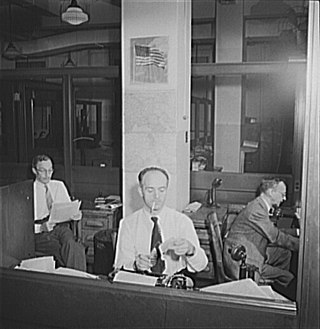
Print syndication distributes news articles, columns, political cartoons, comic strips and other features to newspapers, magazines and websites. The syndicates offer reprint rights and grant permissions to other parties for republishing content of which they own and/or represent copyrights. Other terms for the service include a newspaper syndicate, a press syndicate, and a feature syndicate.
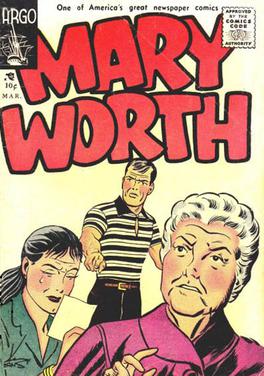
Mary Worth is an American newspaper comic strip that has had an eight-decade run from 1938. Distributed by King Features Syndicate, this soap opera-style strip influenced several that followed. It was created by writer Allen Saunders and artist Dale Connor, and initially appeared under the pseudonym "Dale Allen". Ken Ernst succeeded Connor as artist in 1942.

Rex Morgan, M.D. is an American soap opera comic strip, created May 10, 1948 by psychiatrist Dr. Nicholas P. Dallis under the pseudonym Dal Curtis.

Kerry Drake is the title of a comic strip created for Publishers Syndicate by Alfred Andriola as artist and Allen Saunders as uncredited writer. It debuted on Monday, October 4, 1943, replacing Norman Marsh's Dan Dunn, and was syndicated continuously through June 26, 1983.

Publishers-Hall Syndicate was a newspaper syndicate founded by Robert M. Hall in 1944. Hall served as the company's president and general manager. Over the course of its operations, the company was known as, sequentially, the Hall Syndicate (1944–1946), the New York Post Syndicate (1946–1949), the Post-Hall Syndicate (1949–1955), the Hall Syndicate (1955–1967), and Publishers-Hall Syndicate (1967–1975). The syndicate was acquired by Field Enterprises in 1967, and merged into Field Newspaper Syndicate in 1975. Some of the more notable strips syndicated by the company include Pogo, Dennis the Menace, Funky Winkerbean, Mark Trail, The Strange World of Mr. Mum, and Momma, as well as the cartoons of Jules Feiffer.

Dan Dunn is a fictional detective created by Norman W. Marsh. He first appeared in Detective Dan: Secret Operative No. 48, a proto-comic book from 1933, produced by Humor Publishing. He subsequently appeared in newspaper comic strips from 1933 to 1943.

Our Boarding House is an American single-panel cartoon and comic strip created by Gene Ahern on October 3, 1921 and syndicated by Newspaper Enterprise Association. Set in a boarding house run by the sensible Mrs. Hoople, it drew humor from the interactions of her grandiose, tall-tale-telling husband, the self-styled Major Hoople, with the rooming-house denizens and his various friends and cronies.
A comic strip syndicate functions as an agent for cartoonists and comic strip creators, placing the cartoons and strips in as many newspapers as possible on behalf of the artist. A syndicate can annually receive thousands of submissions, from which only two or three might be selected for representation. In some cases, the work will be owned by the syndicate as opposed to the creator. The Guinness World Record for the world's most syndicated strip belongs to Jim Davis' Garfield, which at that point (2002) appeared in 2,570 newspapers, with 263 million readers worldwide.

Allen Saunders was an American writer, journalist and cartoonist who wrote the comic strips Steve Roper and Mike Nomad, Mary Worth and Kerry Drake.
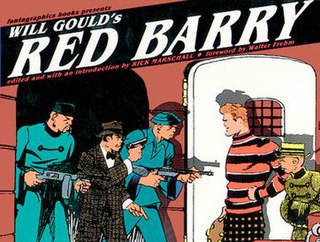
Red Barry is a detective comic strip created by Will Gould (1911–1984) for King Features. The daily strip about two-fisted undercover cop Barry began Monday, March 19, 1934, as one of several strips introduced to compete with Dick Tracy by Chester Gould. A Sunday strip was added on February 3, 1935. The daily strip ran for three years, until August 14, 1937, and the Sunday page ended almost a year later, on July 17, 1938.
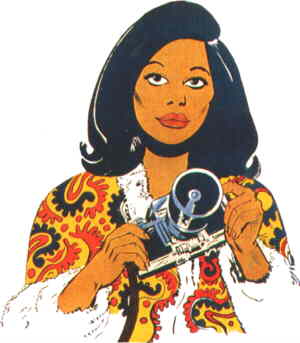
Friday Foster is an American newspaper comic strip, created and written by Jim Lawrence and illustrated by Jorge Longarón. It ran from January 18, 1970, to February 17, 1974 and was notable for featuring one of the first African-American women as the title character in a comic strip. Jackie Ormes' Torchy Brown predated it, although it saw a more limited release in the Afro-American newspaper Pittsburgh Courier.
The Bell Syndicate, launched in 1916 by editor-publisher John Neville Wheeler, was an American syndicate that distributed columns, fiction, feature articles and comic strips to newspapers for decades. It was located in New York City at 247 West 43rd Street and later at 229 West 43rd Street. It also reprinted comic strips in book form.
Barbara Brandon-Croft is an American cartoonist, best known for creating the comic strip Where I'm Coming From, and for being the first nationally syndicated African-American female cartoonist.

Alden Spurr McWilliams generally credited as Al McWilliams and A. McWilliams, was an American comics artist who co-created the first African-American lead character of a comic strip. He won the National Cartoonists Society's 1978 award for Comic Book: Story.
Luther is an American syndicated newspaper comic strip published from 1968 to 1986, created and produced by cartoonist Brumsic Brandon Jr. The series, about an African-American elementary-school child, was the second mainstream comic strip to star an African-American in the lead role, following Dateline: Danger! (1968-1974), the first to do so. Another predecessor, Wee Pals (1965-2014), featured an African-American among an ensemble cast of different races and ethnicities.
Quincy is an American syndicated newspaper comic strip published from July 13, 1970 to October 4, 1986, created and produced by cartoonist Ted Shearer. The series, about an African-American boy being raised by his grandmother in Harlem, was one of the earliest mainstream comic strips to star an African American in the lead role, following Dateline: Danger! (1968-1974) and Luther (1969-1986). Another predecessor, Wee Pals, features an African-American among an ensemble cast of different races and ethnicities.
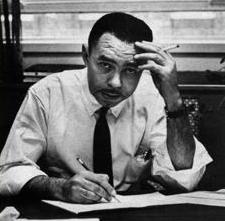
Thaddeus Shearer was an African-American advertising art director and cartoonist whose 1970–1986 Quincy was one of the earliest mainstream comic strips to star an African American in the lead role.
Winthrop is an American syndicated newspaper comic strip that was published between 1966 and 1994, created and produced by cartoonist Dick Cavalli. The series—which derived its comedy from a group of children's nonchalantly world-wise observations—evolved from Cavalli's 1956-1966 strip, Morty Meekle, which featured adult characters.
Morty Meekle is an American syndicated newspaper comic strip that was published between 1956 and 1966, created and produced by cartoonist Dick Cavalli. The series featured the title character dealing with office and dating situations, and, like Fritzi Ritz, which became Nancy after sixteen years, evolved to focus on the younger characters from Cavalli's strip, and was renamed Morty Meekle and Winthrop and then just Winthrop on February 27, 1966.













